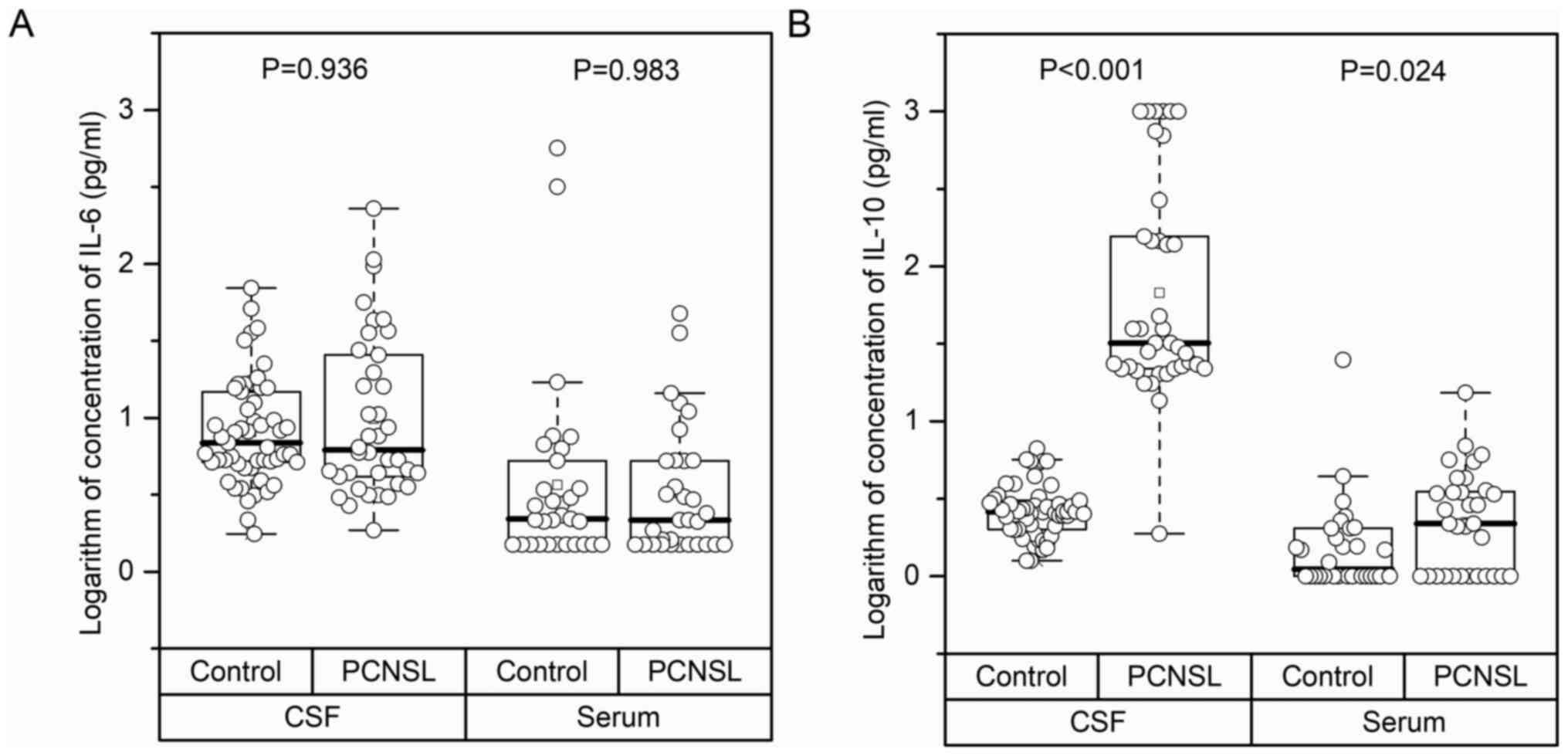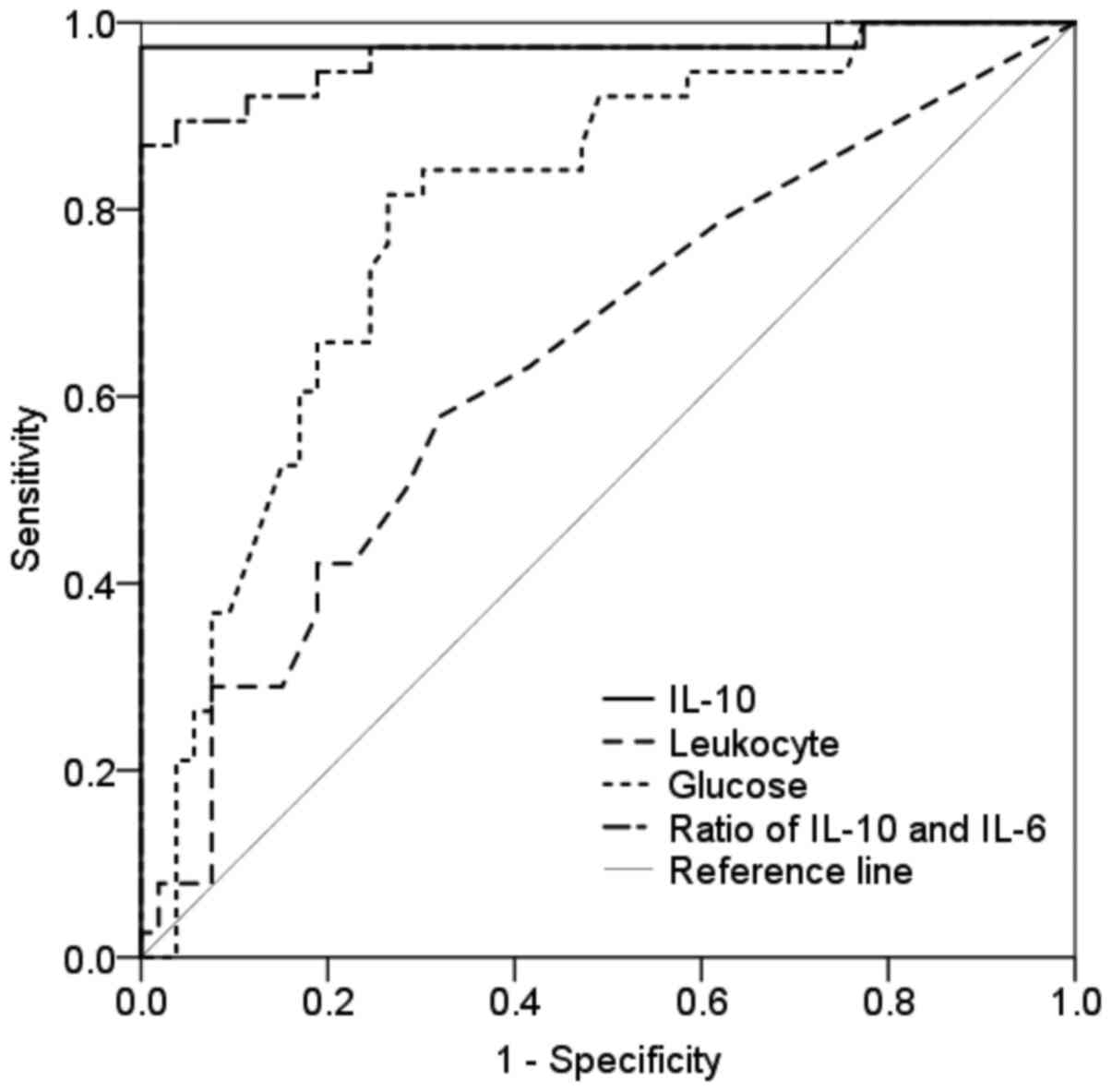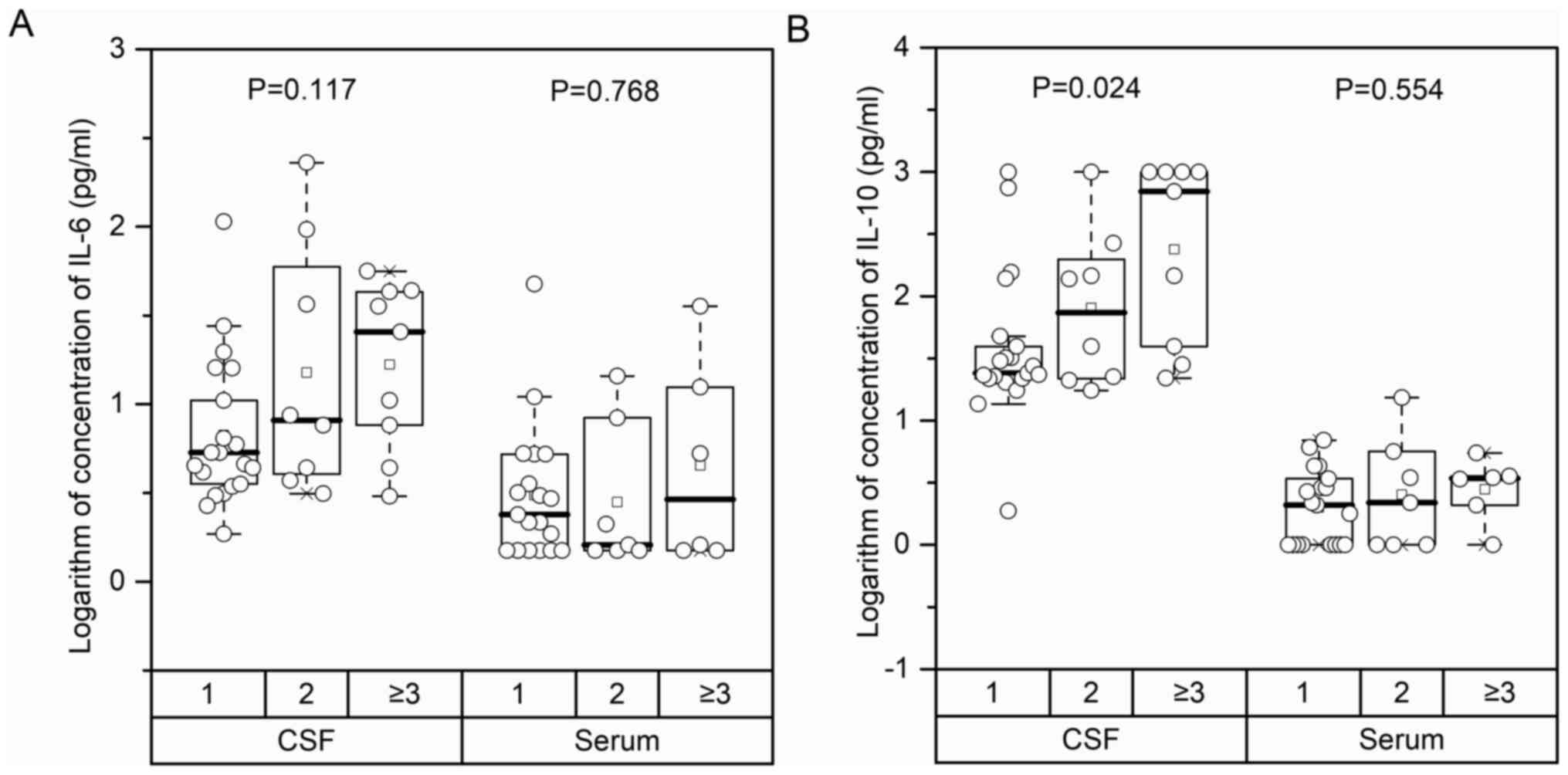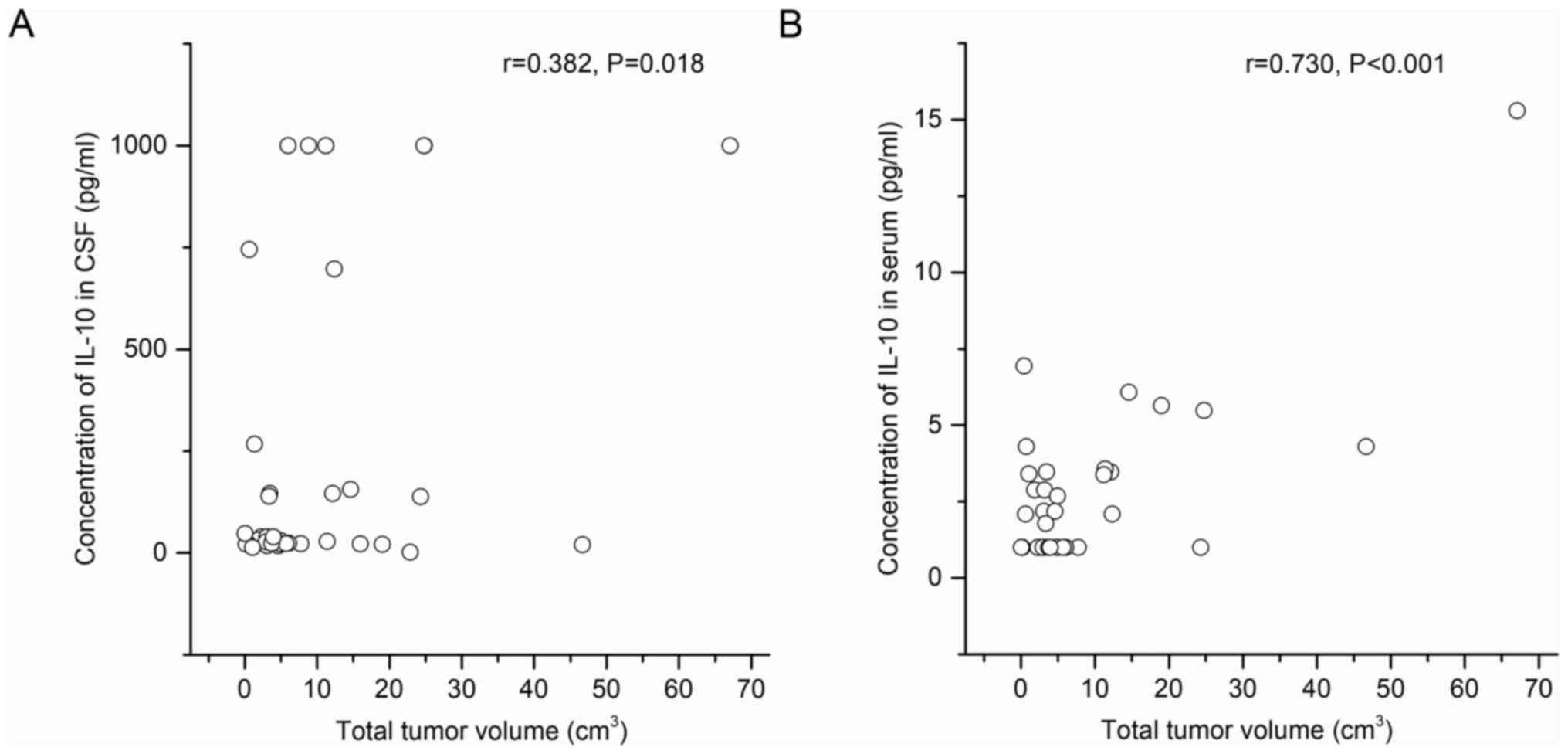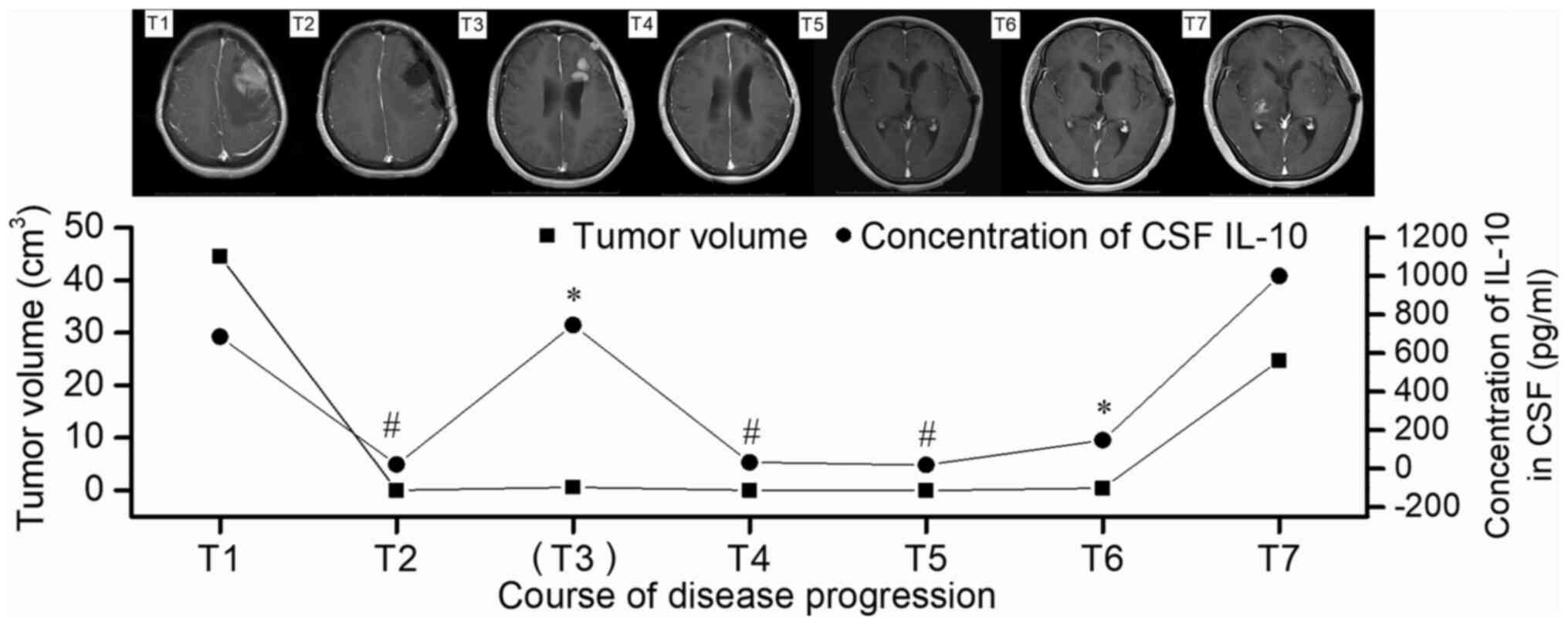|
1
|
Su M, Huang D, Sun L, Dong Z, Wu L and Yu
S: A diagnostic challenge of primary Central nervous system
lymphoma: From the eyes to the brain. Int J Neurosci. 1–7.
2020.(Epub ahead of print). doi: 10.1080/00207454.2020.1773822.
View Article : Google Scholar
|
|
2
|
Bataille B, Delwail V, Menet E,
Vandermarcq P, Ingrand P, Wager M, Guy G and Lapierre F: Primary
intracerebral malignant lymphoma: Report of 248 cases. J Neurosurg.
92:261–266. 2000. View Article : Google Scholar : PubMed/NCBI
|
|
3
|
Hartmann M, Heiland S, Harting I, Tronnier
VM, Sommer C, Ludwig R and Sartor K: Distinguishing of primary
cerebral lymphoma from high-grade glioma with perfusion-weighted
magnetic resonance imaging. Neurosci Lett. 338:119–122. 2003.
View Article : Google Scholar : PubMed/NCBI
|
|
4
|
Bertaux M, Houillier C, Edeline V, Habert
MO, Mokhtari K, Giron A, Bergeret S, Hoang-Xuan K, Cassoux N,
Touitou V, et al: Use of FDG-PET/CT for systemic assessment of
suspected primary central nervous system lymphoma: A LOC study. J
Neurooncol. 148:343–352. 2020. View Article : Google Scholar : PubMed/NCBI
|
|
5
|
Josephson SA, Papanastassiou AM, Berger
MS, Barbaro NM, McDermott MW, Hilton JF, Miller BL and Geschwind
MD: The diagnostic utility of brain biopsy procedures in patients
with rapidly deteriorating neurological conditions or dementia. J
Neurosurg. 106:72–75. 2007. View Article : Google Scholar : PubMed/NCBI
|
|
6
|
Khatab S, Spliet W and Woerdeman PA:
Frameless image-guided stereotactic brain biopsies: Emphasis on
diagnostic yield. Acta Neurochir (Wien). 156:1441–1450. 2014.
View Article : Google Scholar : PubMed/NCBI
|
|
7
|
Ferreri AJM, Cwynarski K, Pulczynski E,
Fox CP, Schorb E, La Rosee P, Binder M, Fabbri A, Torri V,
Minacapelli E, et al: Whole-brain radiotherapy or autologous
stem-cell transplantation as consolidation strategies after
high-dose methotrexate-based chemoimmunotherapy in patients with
primary CNS lymphoma: Results of the second randomisation of the
International Extranodal Lymphoma Study Group-32 phase 2 trial.
Lancet Haematol. 4:e510–e523. 2017. View Article : Google Scholar : PubMed/NCBI
|
|
8
|
Gilbert MR, Wang M, Aldape KD, Stupp R,
Hegi ME, Jaeckle KA, Armstrong TS, Wefel JS, Won M, Blumenthal DT,
et al: Dose-dense temozolomide for newly diagnosed glioblastoma: A
randomized phase III clinical trial. J Clin Oncol. 31:4085–4091.
2013. View Article : Google Scholar : PubMed/NCBI
|
|
9
|
Viaccoz A, Ducray F, Tholance Y, Barcelos
GK, Thomas-Maisonneuve L, Ghesquieres H, Meyronet D, Quadrio I,
Cartalat-Carel S, Louis-Tisserand G, et al: CSF neopterin level as
a diagnostic marker in primary central nervous system lymphoma.
Neuro Oncol. 17:1497–1503. 2015. View Article : Google Scholar : PubMed/NCBI
|
|
10
|
Sasayama T, Nakamizo S, Nishihara M,
Kawamura A, Tanaka H, Mizukawa K, Miyake S, Taniguchi M, Hosoda K
and Kohmura E: Cerebrospinal fluid interleukin-10 is a potentially
useful biomarker in immunocompetent primary central nervous system
lymphoma (PCNSL). Neuro Oncol. 14:368–380. 2012. View Article : Google Scholar : PubMed/NCBI
|
|
11
|
Sasagawa Y, Akai T, Tachibana O and Iizuka
H: Diagnostic value of interleukin-10 in cerebrospinal fluid for
diffuse large B-cell lymphoma of the central nervous system. J
Neurooncol. 121:177–183. 2015. View Article : Google Scholar : PubMed/NCBI
|
|
12
|
Baraniskin A, Kuhnhenn J, Schlegel U,
Maghnouj A, Zollner H, Schmiegel W, Hahn S and Schroers R:
Identification of microRNAs in the cerebrospinal fluid as biomarker
for the diagnosis of glioma. Neuro Oncol. 14:29–33. 2012.
View Article : Google Scholar : PubMed/NCBI
|
|
13
|
Geng M, Xiao H, Liu J, Song Y, Fu P, Cheng
X, Zhang J and Wang G: The diagnostic role and dynamic changes in
cerebrospinal fluid neopterin during treatment of patients with
primary central nervous system lymphoma. Cancer Med. 7:3889–3898.
2018. View Article : Google Scholar : PubMed/NCBI
|
|
14
|
Hoekzema R, Murray PI, van Haren MA, Helle
M and Kijlstra A: Analysis of interleukin-6 in endotoxin-induced
uveitis. Invest Ophthalmol Vis Sci. 32:88–95. 1991.PubMed/NCBI
|
|
15
|
Salles G and Coiffier B: Inherited
cytokine response and risk of lymphoma. Lancet Oncol. 7:3–4. 2006.
View Article : Google Scholar : PubMed/NCBI
|
|
16
|
Kurzrock R: The role of cytokines in
cancer-related fatigue. Cancer. 92 (Suppl 6):S1684–S1688. 2001.
View Article : Google Scholar
|
|
17
|
Rousset F, Garcia E, Defrance T, Peronne
C, Vezzio N, Hsu DH, Kastelein R, Moore KW and Banchereau J:
Interleukin 10 is a potent growth and differentiation factor for
activated human B lymphocytes. Proc Natl Acad Sci USA.
89:1890–1893. 1992. View Article : Google Scholar : PubMed/NCBI
|
|
18
|
Fluckiger AC, Durand I and Banchereau J:
Interleukin 10 induces apoptotic cell death of B-chronic
lymphocytic leukemia cells. J Exp Med. 179:91–99. 1994. View Article : Google Scholar : PubMed/NCBI
|
|
19
|
Stewart JP, Behm FG, Arrand JR and Rooney
CM: Differential expression of viral and human interleukin-10
(IL-10) by primary B cell tumors and B cell lines. Virology.
200:724–732. 1994. View Article : Google Scholar : PubMed/NCBI
|
|
20
|
Mocellin S, Marincola FM and Young HA:
Interleukin-10 and the immune response against cancer: A
counterpoint. J Leukoc Biol. 78:1043–1051. 2005. View Article : Google Scholar : PubMed/NCBI
|
|
21
|
Moore KW, de Waal MR, Coffman RL and
O'Garra A: Interleukin-10 and the interleukin-10 receptor. Annu Rev
Immunol. 19:683–765. 2001. View Article : Google Scholar : PubMed/NCBI
|
|
22
|
Mosser DM and Zhang X: Interleukin-10: New
perspectives on an old cytokine. Immunol Rev. 226:205–218. 2008.
View Article : Google Scholar : PubMed/NCBI
|
|
23
|
O'Garra A, Barrat FJ, Castro AG, Vicari A
and Hawrylowicz C: Strategies for use of IL-10 or its antagonists
in human disease. Immunol Rev. 223:114–131. 2008. View Article : Google Scholar : PubMed/NCBI
|
|
24
|
Frappaz D, Bonneville-Levard A, Ricard D,
Carrie S, Schiffler C, Xuan KH and Weller M: Assessment of
Karnofsky (KPS) and WHO (WHO-PS) performance scores in brain tumour
patients: The role of clinician bias. Support Care Cancer. Aug
13–2020.(Epub ahead of print). doi: 10.1007/s00520-020-05663-y.
View Article : Google Scholar : PubMed/NCBI
|
|
25
|
Teusch W: Relationships between Pandy's
test and syphilis reactions in the spinal fluid. Med Monatsschr.
4:290–291. 1950.(In Undetermined Language). PubMed/NCBI
|
|
26
|
Louis DN, Perry A, Reifenberger G, von
Deimling A, Figarella-Branger D, Cavenee WK, Ohgaki H, Wiestler OD,
Kleihues P and Ellison DW: The 2016 World health organization
classification of tumors of the central nervous system: A summary.
Acta Neuropathol. 131:803–820. 2016. View Article : Google Scholar : PubMed/NCBI
|
|
27
|
Nabors LB, Portnow J, Ammirati M, Baehring
J, Brem H, Butowski N, Fenstermaker RA, Forsyth P, Hattangadi-Gluth
J, Holdhoff M, et al: NCCN guidelines insights: Central nervous
system cancers, version 1.2017. J Natl Compr Canc Netw.
15:1331–1345. 2017. View Article : Google Scholar : PubMed/NCBI
|
|
28
|
Sugita Y, Muta H, Ohshima K, Morioka M,
Tsukamoto Y, Takahashi H and Kakita A: Primary central nervous
system lymphomas and related diseases: Pathological characteristics
and discussion of the differential diagnosis. Neuropathology.
36:313–324. 2016. View Article : Google Scholar : PubMed/NCBI
|
|
29
|
Fluss R, Faraggi D and Reiser B:
Estimation of the Youden index and its associated cutoff point.
Biometrical J. 47:458–472. 2005. View Article : Google Scholar
|
|
30
|
El Far M, Fouda M, Yahya R and El Baz H:
Serum IL-10 and IL-6 levels at diagnosis as independent predictors
of outcome in non-Hodgkin's lymphoma. J Physiol Biochem.
60:253–258. 2004. View Article : Google Scholar : PubMed/NCBI
|
|
31
|
Duletić AN, Stifter S, Dvornik S, Skunca Z
and Jonjić N: Correlation of serum IL-6, IL-8 and IL-10 levels with
clinicopathological features and prognosis in patients with diffuse
large B-cell lymphoma. Int J Lab Hematol. 30:230–239. 2008.
View Article : Google Scholar : PubMed/NCBI
|
|
32
|
Song Y, Zhang W, Zhang L, Wu W, Zhang Y,
Han X, Yang C, Zhang L and Zhou D: Cerebrospinal Fluid IL-10 and
IL-10/IL-6 as accurate diagnostic biomarkers for primary central
nervous system large B-cell lymphoma. Sci Rep. 6:386712016.
View Article : Google Scholar : PubMed/NCBI
|
|
33
|
Alas S, Emmanouilides C and Bonavida B:
Inhibition of interleukin 10 by rituximab results in
down-regulation of bcl-2 and sensitization of B-cell non-Hodgkin's
lymphoma to apoptosis. Clin Cancer Res. 7:709–723. 2001.PubMed/NCBI
|
|
34
|
Vega MI, Huerta-Yepaz S, Garban H,
Jazirehi A, Emmanouilides C and Bonavida B: Rituximab inhibits p38
MAPK activity in 2F7 BNHL and decreases IL-10 transcription:
Pivotal role of p38 MAPK in drug resistance. Oncogene.
23:3530–3540. 2004. View Article : Google Scholar : PubMed/NCBI
|
|
35
|
van Westrhenen A, Smidt LCA, Seute T,
Nierkens S, Stork ACJ, Minnema MC and Snijders TJ: Diagnostic
markers for CNS lymphoma in blood and cerebrospinal fluid: A
systematic review. Brit J Haematol. 182:384–403. 2018. View Article : Google Scholar
|
|
36
|
Whitcup SM, Stark-Vancs V, Wittes RE,
Solomon D, Podgor MJ, Nussenblatt RB and Chan CC: Association of
interleukin 10 in the vitreous and cerebrospinal fluid and primary
central nervous system lymphoma. Arch Ophthalmol. 115:1157–1160.
1997. View Article : Google Scholar : PubMed/NCBI
|
|
37
|
Salmaggi A, Eoli M, Corsini E, Gelati M,
Frigerio S, Silvani A and Boiardi A: Cerebrospinal fluid
interleukin-10 levels in primary central nervous system lymphoma: A
possible marker of response to treatment? Ann Neurol. 47:137–138.
2000. View Article : Google Scholar : PubMed/NCBI
|
|
38
|
Rubenstein JL, Wong VS, Kadoch C, Gao HX,
Barajas R, Chen L, Josephson SA, Scott B, Douglas V, Maiti M, et
al: CXCL13 plus interleukin 10 is highly specific for the diagnosis
of CNS lymphoma. Blood. 121:4740–4748. 2013. View Article : Google Scholar : PubMed/NCBI
|
|
39
|
Mabray MC, Barajas RF, Villanueva-Meyer
JE, Zhang CA, Valles FE, Rubenstein JL and Cha S: The combined
performance of ADC, CSF CXC chemokine ligand 13, and CSF
interleukin 10 in the diagnosis of central nervous system lymphoma.
AJNR Am J Neuroradiol. 37:74–79. 2016. View Article : Google Scholar : PubMed/NCBI
|
|
40
|
Nguyen-Them L, Costopoulos M, Tanguy ML,
Houillier C, Choquet S, Benanni H, Elias-Shamieh R, Armand M,
Faivre G, Glaisner S, et al: The CSF IL-10 concentration is an
effective diagnostic marker in immunocompetent primary CNS lymphoma
and a potential prognostic biomarker in treatment-responsive
patients. Eur J Cancer. 61:69–76. 2016. View Article : Google Scholar : PubMed/NCBI
|
|
41
|
Ikeguchi R, Shimizu Y, Shimizu S and
Kitagawa K: CSF and clinical data are useful in differentiating CNS
inflammatory demyelinating disease from CNS lymphoma. Mult Scler.
24:1212–1223. 2018. View Article : Google Scholar : PubMed/NCBI
|
|
42
|
Thiel E, Korfel A, Martus P, Kanz L,
Griesinger F, Rauch M, Roth A, Hertenstein B, von Toll T,
Hundsberger T, et al: High-dose methotrexate with or without whole
brain radiotherapy for primary CNS lymphoma (G-PCNSL-SG-1): A phase
3, randomised, non-inferiority trial. Lancet Oncol. 11:1036–1047.
2010. View Article : Google Scholar : PubMed/NCBI
|
|
43
|
Sasayama T, Tanaka K, Mizowaki T,
Nagashima H, Nakamizo S, Tanaka H, Nishihara M, Mizukawa K, Hirose
T, Itoh T and Kohmura E: Tumor-associated macrophages associate
with cerebrospinal fluid interleukin-10 and survival in primary
central nervous system lymphoma (PCNSL). Brain Pathol. 26:479–487.
2016. View Article : Google Scholar : PubMed/NCBI
|
|
44
|
Dukers DF, Jaspars LH, Vos W, Oudejans JJ,
Hayes D, Cillessen S, Middeldorp JM and Meijer CJ: Quantitative
immunohistochemical analysis of cytokine profiles in Epstein-Barr
virus-positive and -negative cases of Hodgkin's disease. J Pathol.
190:143–149. 2000. View Article : Google Scholar : PubMed/NCBI
|
|
45
|
Voorzanger N, Touitou R, Garcia E,
Delecluse HJ, Rousset F, Joab I, Favrot MC and Blay JY: Interleukin
(IL)-10 and IL-6 are produced in vivo by non-Hodgkin's lymphoma
cells and act as cooperative growth factors. Cancer Res.
56:5499–5505. 1996.PubMed/NCBI
|
|
46
|
Wu X, Hsu DK, Wang KH, Huang Y, Mendoza L,
Zhou Y and Hwang ST: IL-10 is overexpressed in human cutaneous
T-cell lymphoma and is required for maximal tumor growth in a mouse
model. Leuk Lymphoma. 60:1244–1252. 2019. View Article : Google Scholar : PubMed/NCBI
|
|
47
|
Leppa S, Jorgensen J, Tierens A, Meriranta
L, Ostlie I, de Nully BP, Fagerli UM, Larsen TS, Mannisto S,
Munksgaard L, et al: Patients with high-risk DLBCL benefit from
dose-dense immunochemotherapy combined with early systemic CNS
prophylaxis. Blood Adv. 4:1906–1915. 2020. View Article : Google Scholar : PubMed/NCBI
|















